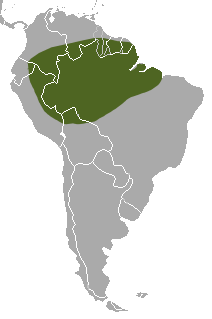South American weasel
| South American weasel | ||||||||||||
|---|---|---|---|---|---|---|---|---|---|---|---|---|
| Systematics | ||||||||||||
|
||||||||||||
| Scientific name | ||||||||||||
| Grammogals | ||||||||||||
| Cabrera , 1940 | ||||||||||||
| species | ||||||||||||
|
The South American weasel ( Grammogale ) is a subgenus within the genus Mustela , in which weasels , minks and polecats are grouped together. Two species are included in this subgenus:
- the Colombian weasel ( Mustela felipei )
- and the tropical weasel ( Mustela africana ).
features
South American weasels have the usual physique of their species with an elongated trunk and relatively short legs and tail. The toes are webbed, which is an adaptation to the semi-aquatic way of life. Their fur is brownish in color, with the Colombian weasel being a bit darker and smaller than the tropical weasel. These animals reach a head-trunk length of 21 to 38 centimeters, the tail is around 11 to 21 centimeters long.
distribution and habitat
South American weasels always live near water in forests. While the Colombian weasel lives in mountainous regions up to 2700 meters above sea level in Colombia and Ecuador , the tropical weasel is native to the Amazon basin in northern Brazil , Ecuador and northern Peru . Almost nothing is known about their way of life.
The Colombian weasel lives in a relatively small area that is also strongly threatened by deforestation; the IUCN classifies it as "endangered" ( vulnerable ). Overall, the tropical weasel has rarely been sighted, but given its large area of distribution, the IUCN classifies it as “not endangered” ( least concern ).
Individual evidence
- ↑ Ronald M. Nowak: Walker's Mammals of the World . 6th edition. tape 1 . Johns Hopkins University Press, Baltimore 1999, ISBN 0-8018-5789-9 , pp. 705-706 ( Google Books ).
- ↑ Mustela felipei in the endangered Red List species the IUCN 2009. Posted by: L. Emmons, K. slipway, 2008. Accessed November 7 in 2009.
- ↑ Mustela africana in the endangered Red List species the IUCN 2009. Posted by: L. Emmons, K. slipway, 2008. Accessed November 7 in 2009.
